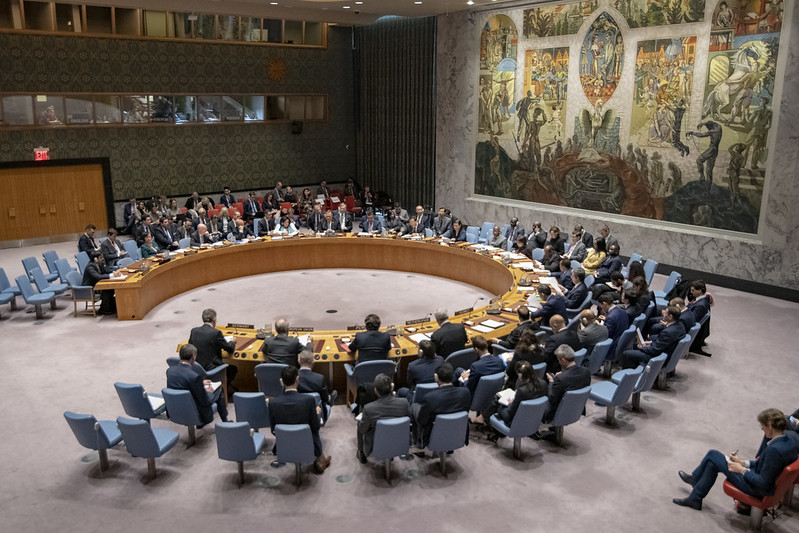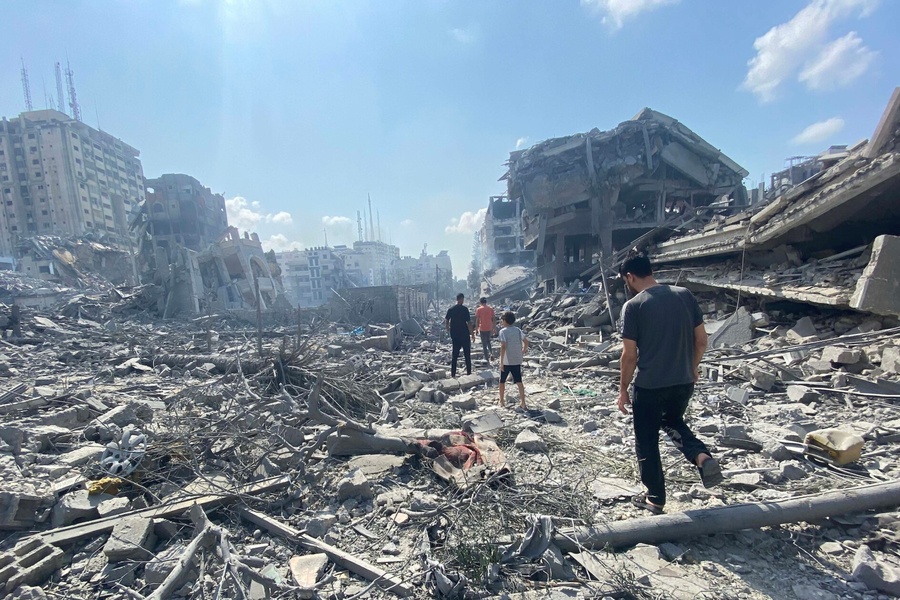The U.S. Gets U.N. Support for the Taliban Deal
With this U.N. Security Council vote, the U.S. has made good on a promise included in the peace agreement with the Taliban. But many are skeptical of the deal.

Published by The Lawfare Institute
in Cooperation With

On Tuesday, March 10, the U.N. Security Council voted unanimously in favor of a U.S.-sponsored resolution designed to support the recent U.S.-Taliban peace deal. The resolution calls for the Security Council to recognize the deal as part of “significant steps towards ending the war” in Afghanistan and to provide “sustained support” to achieve peace through negotiations.
With this vote, the U.S. has made good on a promise included in the peace agreement with the Taliban: Under Part 3, Section 1, the U.S. is required to “request the recognition and endorsement of the United Nations Security Council.” Now, the members of the Security Council have brought themselves into the accord, making it a multinational agreement rather than a bilateral pact.
But former senior U.S. national security policymakers have been skeptical of the terms of the deal, which already appear to be under pressure from renewed Taliban-initiated violence. Additionally, others have expressed concern with how this deal fits into the commitments the U.S. has made to the internationally recognized Afghan government via a separate U.S.-Afghanistan joint declaration.
Comparing the U.S.-Taliban Peace Deal and the U.S.-Afghanistan Joint Statement
On Feb. 29, the United States signed the “Agreement for Bringing Peace to Afghanistan” with the self-declared Islamic Emirate of Afghanistan, commonly referred to as the Taliban. The same day, the United States and the Islamic Republic of Afghanistan—the country’s internationally recognized government—released a bilateral joint declaration for “Bringing Peace to Afghanistan.”
Perhaps the most obvious and consequential aspect of both the peace agreement and the joint declaration is that each document is missing a critical signatory: The internationally recognized and NATO-backed Afghan government is not a party to the Taliban-U.S. peace agreement, and the Taliban is absent from the U.S.-Afghan joint declaration. This is, on the face of it, strange. But it is a result of the U.S. acceding to the Taliban’s preconditions for an agreement: The Taliban has refused to recognize the Afghan government’s legitimacy and will not negotiate with it until a full U.S. withdrawal takes place.
Beyond that, the documents have a substantial conceptual overlap. Broadly, both the peace agreement and the joint declaration conclude that peace can be achieved if the Taliban, the Afghan government and the U.S. take the following steps: The Taliban stops any group or individual from staging threats from Afghanistan against the security of the U.S. and its allies; the U.S. establishes a timeline for the withdrawal of all U.S. and coalition forces; the Afghan government and the Taliban start peace talks, at the end of a full U.S. withdrawal; and the Afghan government and the Taliban develop terms for a permanent and comprehensive cease-fire.
The two documents characterize the last two parts of the expected requirements for peace in meaningfully different ways. The third step of the U.S.-Taliban peace agreement states that after full guarantees for the first commitments are made in the presence of international witnesses, the Taliban should start negotiations with the Afghanistan government. Conversely, the third step of the U.S.-Afghan joint declaration presumes that “a political settlement resulting from intra-Afghan dialogue and negotiations between the Taliban and an inclusive negotiating team of the Islamic Republic of Afghanistan” will occur.
The fourth step of the peace agreement states that “[a] permanent and comprehensive ceasefire will be an item on the agenda of the intra-Afghan dialogue and negotiations.” By contrast, the joint declaration provides that a “permanent and comprehensive ceasefire” is a necessary fourth step of a sustainable peace. In other words, the Afghan government expects the Taliban to commit to negotiate in good faith toward a peaceful end to the conflict. But the Taliban has only promised to talk to the Afghan government about a lasting peace and has not bound itself to concluding the conflict peacefully.
The U.S.-Taliban agreement lays out a detailed plan for an exchange of prisoners between the Taliban and the Afghan government. Specifically, the U.S. has committed the national government of Afghanistan to releasing “[u]p to five thousand (5,000) [Taliban] prisoners” in exchange for the Taliban releasing “one thousand (1,000) prisoners of the [Afghan government].” But the Afghan government has not agreed to do this. Part 2, Section 4, of the joint declaration between the Afghan government and the U.S. says only that the Afghan government will “participate in a U.S.-facilitated discussion with Taliban representatives on confidence building measures, to include determining the feasibility of releasing significant numbers of prisoners on both sides.”
This discrepancy has already started to cause problems. Only two days after the peace agreement and joint declaration were signed, the Washington Post reported that the Afghan government was refusing to release the prisoners as outlined in the U.S.-Taliban peace agreement, potentially threatening the deal’s viability.
This is not the only potential sticking point. In both the peace agreement and the joint declaration, the U.S. commits to reducing “the number of U.S. forces in Afghanistan to 8,600” over a 135-day period and removing all U.S. and U.S.-allied forces over the subsequent nine and a half months. But in the U.S.-Afghan joint declaration, the U.S. makes both these actions contingent on “the Taliban’s fulfillment of its commitments.” This crucial clause does not exist in the associated U.S.-Taliban peace agreement.
The peace agreement and the joint resolution are supposed to set the stage for a U.S. and coalition force troop withdrawal under the first two steps of the agreed-upon peace process. But the U.N. resolution appears to be the framework for the intra-Afghan discussions under Parts 3 and 4: In Part 3, Section 1, of both the peace agreement and the joint declaration, the U.S. promises to “request the recognition and endorsement of the U.N. Security Council for [each] agreement.”
The U.N. Security Council Resolution
The U.N. resolution voices the Security Council’s encouragement for
the sustained support of the United Nations and international partners and their significant and ongoing contributions to the cause of peace, including the willingness of multiple countries to facilitate or convene intra-Afghan negotiations in order to achieve a political settlement and a permanent and comprehensive ceasefire.
The resolution also supports “the important role that the United Nations, together with its assistance mission, the United Nations Assistance Mission in Afghanistan (UNAMA), will continue to play in promoting peace and stability in Afghanistan.” Tadamichi Yamamoto, the head of the mission, has been supportive of the U.S.-Taliban agreement and was in Doha, Qatar, for its signing.
Additionally, the resolution calls for the inclusion of the United Nations and international partners in intra-Afghan negotiations. The hope is that this will help achieve a permanent cease-fire and a political settlement designed to protect the rights of women, youth and minorities—an important step given the Taliban’s dismal record of human rights abuses.
Following intense negotiations with the People’s Republic of China (PRC) and the Russian Federation late Monday night, new language was added to the resolution. Specifically, the U.S. agreed to let the PRC introduce language promoting the Chinese Belt and Road Initiative. As a result, the following language (in italics) was placed in the final resolution, which states that the U.N. Security Council:
Welcomes work underway by the international community to prepare for the delivery of humanitarian assistance and development assistance throughout Afghanistan with the aim of addressing humanitarian needs, promoting reconciliation, and extending the benefits of peace, further welcomes the efforts of regional cooperation for regional development, and stresses the importance of international and regional economic cooperation for the reconstruction of Afghanistan (emphasis added).
Additionally, Russia successfully pushed to add an introductory paragraph addressing the Afghan drug trade, which burgeoned under Taliban rule. The resolution now states that the Security Council is “[b]earing in mind the urgent need for all Afghan parties to counter the world drug problem with the goal of combating traffic in opiates originating from Afghanistan.”
The resolution proposes to review sanctions imposed by the U.N. on the Taliban and other groups in Afghanistan once intra-Afghan negotiations have begun. The language here was also changed to add some flexibility on the lifting of those sanctions and to encourage U.N. member states to submit reports.
The final resolution also introduced the possibility that U.N. sanctions on Taliban leaders could be lifted if they chose to come to the table (additions in italics):
Expresses its readiness upon the commencement of the intra-Afghan negotiations to consider the start of the review of the status of designations of individuals, groups, undertakings and entities on the List established and maintained pursuant to resolution 1988 (2011), in accordance with relevant Security Council resolutions, in order to support the peace process, and urges all States to conduct without any delay national reviews, mindful that Taliban action, or the lack thereof, to further reduce violence, make sustained efforts to advance intra-Afghan negotiations, and otherwise cease to engage in or support activities that threaten the peace, stability and security of Afghanistan, will affect the review.
This section was originally written by the U.S. to fulfill a commitment outlined in the U.S.-Taliban peace agreement. Part 1, Section E, of that document specifically states: “With the start of intra-Afghan negotiations, the United States will start diplomatic engagement with other members of the United Nations Security Council and Afghanistan to remove members of [the Taliban] from the sanctions list.” We learned that an earlier version of the resolution was more explicit in its desire to unequivocally lift these sanctions, but the Security Council decided to proceed with a less definitive resolution.
Despite the Security Council resolution, the peace agreement and the joint declaration, the U.N.’s role in Afghanistan remains unclear in the wake of a U.S. and coalition withdrawal. Richard Gowan, U.N. director at the International Crisis Group, an independent international conflict research organization, told us: “There is a need for a neutral mediator to manage intra-Afghan talks. That doesn't necessarily have to be a U.N. envoy, but the Security Council could endorse a mediator and the U.N. secretariat could back up the process. Our view is that a U.N. role in the next stage of the process is not essential, but it would give the talks some extra international credibility.”
Gowan said that the U.N. could also help convene Afghanistan’s neighbors and other “concerned states” to discuss how to support the peace talks.
“U.N. agencies still also have important humanitarian work to do in Afghanistan … while the idea of U.N. peacekeeping force in Afghanistan has bubbled up occasionally over the years, I don’t think it’s a serious idea now.”
Is the Underlying Taliban Peace Deal Feasible?
Despite the U.N. resolution and efforts by the U.S. to make both the peace agreement and the joint declaration viable, experts remain skeptical given renewed violence and the deals’ structure. And, without a viable peace agreement, the Security Council resolution alone will not have a substantial effect on the violence.
Almost immediately after the deal was signed, the Taliban resumed offensive operations against the Afghan government. During one of these assaults, the U.S. provided direct air support to Afghan Security Forces. “We continue to press all sides to stop posturing, start a practical discussion about prisoner releases, knuckle down and prepare for the upcoming inter-Afghan negotiations,” Defense Secretary Mark Esper said to senators last week.
Former acting CIA Director Michael Morell remains skeptical about Taliban intentions.
“No matter what the Taliban say or sign, they will never come to an agreement with the Afghan government, they will continue to fight for their one-party state, they will win in rather short order, and they will allow al-Qaeda to have safe haven,” Morell told us. “The similarities here with our ‘peace’ agreement with North Vietnam and the eventual outcome there are powerful.”
Other former policymakers familiar with the deal agreed that in the documents, the U.S. promises concrete actions, including a timeline for the complete withdrawal of U.S. and allied forces, and in exchange the Taliban provided no verifiable concessions.
As a result, the Taliban is in a position to renege on its commitments without serious consequences, while the Afghan government is left to fight the insurgent group on its own.
John Negroponte, the former director of national intelligence and former U.S. ambassador to the U.N. and Iraq, told us, “There is no meaningful enforcement mechanism and the prospect for peace between the Afghan parties will depend very much on continued U.S. support to the current Afghan government ... and retaining at least some U.S. military capability in-country to support the government in the event of renewed large scale hostilities.”
“The fact that the agreement is a strictly bilateral one between the U.S. government and the Taliban is troubling and raises the specter of differing interpretations of what was agreed, as we are already seeing on the prisoner issue,” Negroponte said. “This could in turn lead to disputes between the U.S. government and the Afghan government leading to the U.S. government punishing it for what the U.S. government considers noncompliance with terms it negotiated with little or no Afghan buy-in.”
Negroponte is among several former and current administration officials who expressed concerns about the likely success of the new peace deal. Former CIA Director and Commander of U.S. Central Command Gen. David Petraeus and Vance Serchuk of the Center for a New American Security argued in November that any potentially viable peace agreement must require the Taliban to make a total, unequivocal break with international terrorism. “The Taliban must pledge to break ties with designated terrorist groups everywhere and show through active cooperation with the United States their willingness to fight them,” they wrote.
But the peace deal does not develop any method of ensuring that the Taliban eliminates extremist threats to the United States or to U.S. allies. As Petraeus and Serchuk noted:
[I]f the Taliban is sincere about turning against groups such as al-Qaeda, why wouldn’t it—like other U.S. counterterrorism partners around the world—welcome all the international help it can get against a common enemy? The Taliban’s vehement insistence that all U.S. troops leave Afghanistan strongly suggests that its purpose in peace talks isn’t to transform its relationship with the United States but to evict its forces so that they can then overthrow the Afghan government—which, by contrast, has been a steadfast U.S. ally against terror.
Morell also observed that in light of the deal, the U.S. anti-terrorism strategy must pivot from fighting to monitoring: “We no longer have the domestic political support here at home to stay. So, we are going to have to figure out how to monitor al-Qaeda from an intelligence perspective and figure out how we can build a capability to ‘reach out and touch’ them from a military perspective if we have to do so.”
“This agreement, like the Paris Agreement on Vietnam in 1972, is euphemistically called an agreement ‘to bring peace’ to Afghanistan, whereas in fact it is an agreement to withdraw U.S. troops and also permit the withdrawal of NATO forces,” Negroponte said. “The agreement will likely reduce our involvement in Afghanistan but it is not likely to bring an end to the war.”
Editor's note: The piece has been updated to specify that the 5,000 prisoners that the deal stipulates will be released by the Afghan government are alleged Taliban affiliates.






